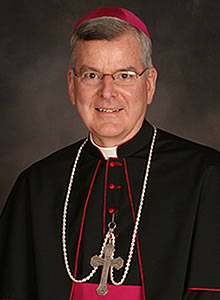
Continuing a long tradition of my predecessors, I look for a book to give to my priests every Christmas with the hope that they will find some enjoyment, insight and personal support for their public ministry or personal lives.
I have to admit that this year’s choice of Msgr. Stephen Rossetti’s “Why Priests Are Happy” served as a perfect response to the mischaracterization in the media that priests, by and large, are a sad, lonely, overburdened, overworked and depressed group of men. With highly scientific and painstakingly well-researched data, Msgr. Rossetti establishes that, in fact, just the opposite is true.
As a result of his 2009 scientific survey, Msgr. Rossetti found that 90 to 92.4 percent of the priests reporting agreed or strongly agreed that they are happy as priests, and 80 to 88.9 percent say that their morale is good.
These statistics compare favorably to the 2009 Conference Board study of 5,000 American households that reported only 45 percent of the Americans surveyed were satisfied with their work. Considering the negative effects of the 2002 abuse crisis, the reported decline in vocations and the drubbing that mandated celibacy receives in the media, Msgr. Rossetti claims that these findings are quite remarkable.
Much of Msgr. Rossetti’s data comes from two studies he conducted in 2004 and 2009.
The first involved 1,242 diocesan priests from various religious orders, representing 16 dioceses from across the United States. The second study expanded the work of the 2004 study to include 2,782 priests from 23 dioceses spread throughout the country.
In addition, throughout his text, he makes reference to earlier studies done by Dean Hoge, Kennedy and Heckler, Tom Nestor, the National Opinion Research Center as well as the John Jay Report commissioned by the U.S. Conference of Catholic Bishops. The book contains 34 graphs and 50 tables. It claims to be the first such study of priests that compares them to the general population.
One of the chief concerns he raises, however, is in regard to priests who have been ordained from nine to 20 years. His concerns are worthy of note and consideration.
These are priests transitioning into the role of pastor, in which they are expected to be a good employer, an attentive plant manager, a fiscally responsible administrator, as well as a brilliant homilist, a compelling liturgist, a gentle confessor and a wise pastoral counselor. In addition, they find themselves living a lifestyle that has little societal support:
“They are celibate in a sex-crazed society; they are leaders in an institutional religion when increasing skepticism is leveled at organizations and structural religion; they are CEOs of small corporations — that is, parishes — with very few years of experience; and they are Catholic priests at a time when the media continues to pound away in the public forum at the sins of a few” (p. 82).
This cohort of priests ought to be the focused concern of bishops and personal directors. Msgr. Rossetti points out that when he was ordained, a priest had several assignments as an assistant to pastors who helped mentor them into that role.
Today, younger priests are being appointed pastors without the advantage of that invaluable pastoral experience.
Yet, for all the expectations placed upon them, priests today are experiencing surprisingly low levels of burnout and high levels of satisfaction with their lives. The natural question is: Why?
Msgr. Rossetti posits 14 constitutive elements that, as a composite, point to a credible answer. Among the strongest predictors of priestly happiness is:
- a sense of inner peace;
- a relationship with God;
- a view of celibacy as a personal call from God;
- religious obedience in relationship with his bishop, and;
- the frequency of his spiritual exercises, such as private prayer, Liturgy of the Hours, Marian devotion, spiritual reading and a regular, devout reception of the sacrament of penance/reconciliation.
Being a “man of communion,” the priest must also be able to build up solid, close and healthy relationships with priests and laity alike. Such friendships are essential, Msgr. Rossetti maintains, in building a happy and effective priestly life.
In celebrating the 92.4 percent of priests who are happy, Msgr. Rossetti does not ignore the 7.6 percent who are not. In the analysis of the 14 factors, these priests fall at the bottom of the scale with admitted narcissistic traits or feelings of anxiety, depression or low self-esteem, who tend to “work out problems on their own.”
These priests can be a serious concern for the Church, given their level of responsibility and visibility. Such individuals can cause great harm to others and garner much public notoriety for themselves.
Happy to serve
In his foreward to Msgr. Rossetti’s book, noted journalist John L. Allan, Jr., offers the following recommendation to rank-and-file Catholics on the basis of Msgr. Rossetti’s research:
“The priests of this country obviously love serving you and ministering to you, because otherwise there’s no way to explain why they’re basically happy, in the teeth of a culture which constantly tells them they’re not supposed to be. They love you; try to love them back.”
I might add that, as a priest who is your archbishop, I am also deeply happy and feel powerfully blessed to be able to serve you, the People of God in this local Church.
Indeed, my love for you is deepened each day in my daily remembrance of you in prayer. I ask that you keep me, and my brother priests, in your good prayers as well.
God love you!



